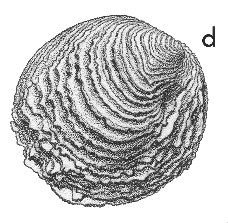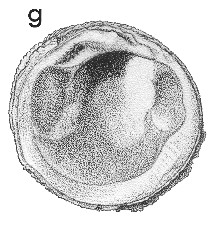
Revised descriptions of New Zealand Cenozoic Mollusca from Beu and Maxwell (1990)

 | Revised descriptions of New Zealand Cenozoic Mollusca from Beu and Maxwell (1990) | 
|
  (Pl. 18d): GS951A, J41/f8475, Target Gully Shellbed, Oamaru, Altonian (GNS) |
  (Pl. 18g): GS951A, J41/f8475, Target Gully Shellbed, Oamaru, Altonian (GNS) |
Beu & Maxwell (1990): Chapter 11; p. 184; pl. 18 d,g.
Classification: Chamidae
Description: Size moderate for genus (length 30-35 mm), right (free) valve subcircular, moderately inflated. Left valve not known but presumably like that of C. huttoni Hector, 1886, i.e. subtrigonal with a flattened anterior attachment area, and more inflated than right valve; cemented to hard substrates. Commarginal sculpture of very prominent, imbricate lamellae, produced into broad frills on well preserved shells and bearing fine radial grooves and ridges. Right hinge with prominent socket on lower part of plate, its upper side strongly and crudely rugose; a rather crude, elongate posterior cardinal tooth and a much narrower and lower ridge bordering the distal portion of a deeply incised ligamental groove. Adductor muscle scars large, ovate, area inside pallial line calcific and therefore differently preserved from that outside. Internal margins smooth.
Comparison: The new (?) species apparently has more distinct radial sculpture on the commarginal lamellae than Chama huttoni (Nukumaruan, Castlepoint, Wairarapa; synonymised with C. ruderalis Lamarck, 1819 by Beu 2006, p. 216) although the available material of C. ruderalis is not well-enough preserved to confirm this. The only other species of Chama to have been described from New Zealand, C. pittensis (Waipipian, Pitt Island), was also considered by Beu (2006) to be a synonym of C. ruderalis. A very distinct chamid, recorded from Otaian beds in Northland, differs from C. ruderalis and the Target Gully species in its larger size (length up to 80 mm) and in having sculpture of finely spinose growth ridges rather than distinct lamellae. Beu (2006, p. 221) pointed out that Chama lamellifera Tenison Woods, 1877 (Longfordian, Early Miocene; Fossil Bluff, N Tasmania) seems very similar to and is possibly conspecific with the New Zealand Early Miocene species illustrated here, a reasonable idea in view of the Indo-Pacific-wide ranges of some modern Chama species.
Chama ranges from about Mangaorapan (upper Waihao River, South Canterbury) to Nukumaruan in New Zealand. Extant species occur elsewhere in warm, shallow waters, cemented to hard substrates. It lives commonly now around southern Australia.
Distribution: Altonian, Target Gully Shellbed, Oamaru (uncommon); ?Pakaurangi Point.
Cite this publication as: "A.G. Beu and J.I. Raine (2009). Revised
descriptions of New Zealand Cenozoic Mollusca from Beu and Maxwell (1990). GNS
Science miscellaneous series no. 27."
© GNS Science, 2009
ISBN
978-0-478-19705-1
ISSN 1177-2441
(Included with a PDF facsimile file
copy of New Zealand Geological Survey Paleontological Bulletin 58 in CD version
from: Publications Officer, GNS Science, P.O. Box 30368 Lower Hutt, New
Zealand)